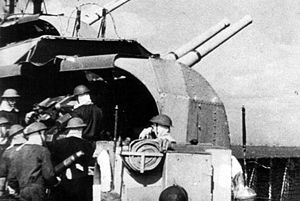- ORP Krakowiak (L115)
-

ORP Krakowiak's artillery turret in actionCareer (Poland) 
Name: ORP Krakowiak Builder: J.S. White & Co.
Cowes, United KingdomLaid down: December 5, 1939 Launched: December 4, 1940 Commissioned: May 28, 1941 Decommissioned: 1946 Fate: scrapped in 1959 General characteristics Class and type: Hunt (Type II) class destroyer Displacement: standard: 1,050 t
total: 1,490 tLength: 85.0 m (278 ft 10 in) Beam: 9.5 m (31 ft 2 in) Draft: 2.4 m (7 ft 10 in) Speed: 27 knots (50 km/h; 31 mph) Armament: 6 × 102 mm (4.0 in) universal Mk XVI guns
4 × 40 mm (1.6 in) Pom-Pom AA cannons
4 × Oerlikon 20 mm (0.79 in) AA cannons
2 × Lewis machine guns
2 × depth charge launchers
2 × Thornycroft depth charge mortars
110 depth chargesORP Krakowiak (L115) was a British Hunt II-class destroyer escort, used by the Polish Navy during World War II. Initially built for the Royal Navy, it bore the name of HMS Silverton during British use..
History
The ship was laid down on December 5, 1939 in J. Samuel White Shipyard in Cowes. Almost a year later it was launched and commissioned by the Royal Navy as HMS Silverton. However, it never entered service in the British naval forces due to lack of experienced crews. Instead, on April 20, 1941 she was leased to the Polish Navy. Officially commissioned on May 22 of that year, she was renamed to ORP Krakowiak, after either a folk dance from Kraków or an inhabitant of that city.
As she was the first ship of her class to be handed to the Poles, until July 10, 1941, her crew spent most of their time training and getting to know the ship. After that date she entered line service in convoy escort role in the North Atlantic. In December of that year she was among the ships to take part in the successful raid against a German naval outpost at Lofoten islands. Throughout the war she also patrolled the North Sea, often engaging in skirmishes with German torpedo boats. In 1943 she was moved to the Mediterranean, where she took part in, among others, the Operation Husky, the Allied invasion of Sicily, and later in the Dodecanese Campaign. Altogether, during World War II she crossed more than 146,000 nautical miles (270,000 km) escorting 206 different convoys, including 9 in the North Atlantic. She downed 3 enemy planes, but the number of enemy vessels sunk is unclear.
After the Allied powers withdrew their support for the Polish government, on September 28, 1946 the ship was decommissioned by the Polish Navy and returned to the British, who commissioned it under its original name. Instantly demobilized, it was reclassified as a frigate and given a new number - F 55. Serving in only rare cases, she spent most of the time in docks, preserved as part of the Reserve Fleet. As such she represented the Reserve Fleet during Queen Elizabeth's coronation celebrations in Spithead in July 1953. In 1959 she was finally decommissioned and sold for scrapping.
External links
- ORP Krakowiak at uboat.net
Hunt-class destroyer Type I  Royal Navy
Royal Navy Royal Danish Navy
Royal Danish Navy Royal Norwegian Navy
Royal Norwegian NavyType III  Royal Navy
Royal Navy Royal Hellenic Navy
Royal Hellenic NavyAdrias (L67) · Adrias (D06) · Kanaris · Miaoulis · Pindos
 Royal Norwegian Navy
Royal Norwegian NavyCoordinates: 44°35′N 16°28′W / 44.583°N 16.467°W
Categories:- Hunt class destroyers of the Royal Navy
- Ships built in the United Kingdom
- 1940 ships
- World War II destroyers of the United Kingdom
- Hunt class destroyers of the Polish Navy
- World War II destroyers of Poland
- Operation Overlord
- Cold War frigates of the United Kingdom
Wikimedia Foundation. 2010.
Look at other dictionaries:
ORP Krakowiak (L115) — ORP Krakowiak (L 115) HMS Silverton … Deutsch Wikipedia
ORP Krakowiak (1941) — ORP Krakowiak (L 115) HMS Silverton … Deutsch Wikipedia
ORP Krakowiak — ist der Name mehrerer polnischer Schiffe. ORP (Okręt Rzeczypospolitej Polskiej Kriegsschiff der Republik Polen) ist der Namenspräfix polnischer Schiffe und Krakowiak bedeutet Krakauer (Einwohner der Stadt und ein polnischer Volkstanz). Schiffe… … Deutsch Wikipedia
HMS Silverton — ORP Krakowiak (L 115) HMS Silverton … Deutsch Wikipedia
Hunt-Klasse (Zerstörer) — Griechischer Zerstörer Adrias (die ehemalige HMS Border (L67)) Die Hunt Klasse war eine Bauserie britischer Geleitzerstörer im Zweiten Weltkrieg. Der Name Hunt bedeutet Jagd, wird hier aber im Sinne von Hundemeute verwandt, und geht auf die… … Deutsch Wikipedia
